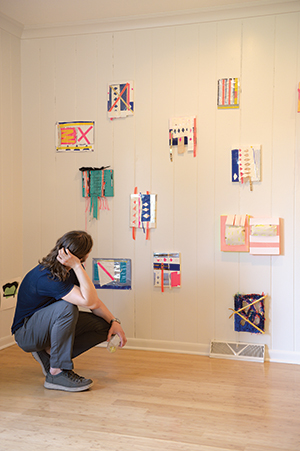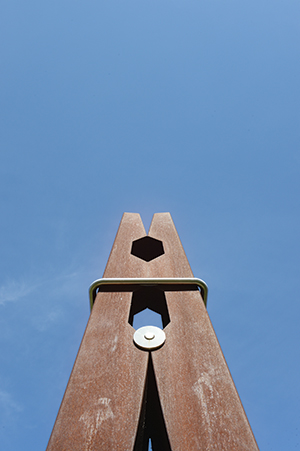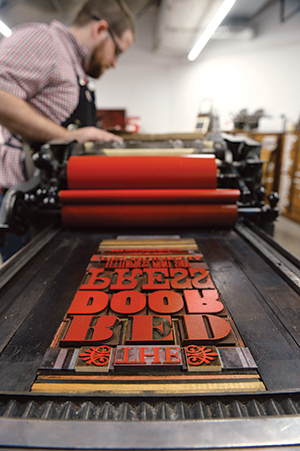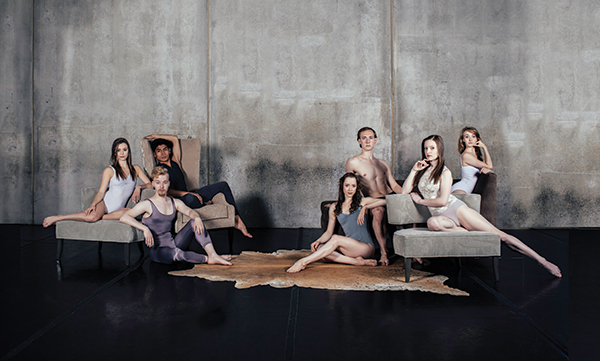
Writer: Michael Morain
Photographer: Duane Tinkey
Phil Barber was tired of looking at the abandoned lot across the street from his home near Southwest Ninth and McKinley.
So he bought it, hauled away the old tires, hacked back the overgrown brush, laid pipes to drain swampy patches and eventually put up a sculpture. It’s a big steel clothespin that his friend, the late Chuck Mettler, made in the jumbo style of Claes Oldenburg.
Then came another sculpture, and another. Today a dozen pieces by local artists fill what is now the South Des Moines Sculpture Park.
“We call it the poor man’s Pappajohn Park,” Barber says.
He was referring, of course, to the 4.4-acre chunk of downtown real estate that John and Mary Pappajohn filled in 2009 with their own collection of sculptures, then valued at around $40 million. The couple has added several others over the years and watched their visionary gift transform Des Moines in ways they most likely never imagined.
But for all the hefty multimillion-dollar additions to the city’s cultural scene over the last 15 years—the Principal Riverwalk, the Des Moines Social Club, the redesigned Cowles Commons—many of the most interesting changes have happened quietly, at the grass-roots level, like Barber’s project on the south side.
Several factors have fertilized the cultural landscape, starting with the internet and the DIY mindset it enables, but also the “Buy Fresh, Buy Local” movement, which has spread beyond the realm of food. New and returning residents—boomerang Iowans—have irrigated local culture with imported ideas.

Redefining Art
“The word ‘art’ is being expanded and stretched and kind of redefined,” says Des Moines native Emily Susanin Kessinger, who moved back in 2016 with her husband, Mason, and opened Yellow Door Gallery in their home on Wakonda Drive.
She listed a handful of projects and hard-to-define collectives that have popped up around town over the last few years. The Barnum Factory stages events in an old paint factory on the near north side. The micro-granting group and traveling exhibition series called Chicken Tractor roosted for a while in the now-closed Transient Gallery in Valley Junction.
Other nomadic groups include the Riverview Artist Salon, the theatrical Open Door Rep, and City Sounds, which plops custom-painted pianos on downtown sidewalks every summer. HomeDitty started in Jay and Katie Byers’ living room and has now built a house-concert empire in 35 states.
Many of these projects are guided by a mission statement—or a manifesto, depending on their founders’ sense of rebellion—but it takes more than words to make them last.
“You have to be patient,” Susanin Kessinger says. “There aren’t a lot of barriers here, but people aren’t always early adopters. Establishing trust and real relationships takes time.”
She says she was delighted—and a little surprised—when Moberg Gallery helped her stage a show by Rob Stephens, one of the artists Moberg represents. Galleries in bigger cities where she has lived, like Denver and Chicago, tend to be more territorial.

Playing Nice
In Des Moines, performing-arts presenters usually play nice, too. When Hoyt Sherman Place impresario Robert Warren can’t fit an act into the schedule there, he often calls up Sam Summers at Wooly’s or Jeff Chelesvig at Des Moines Performing Arts. As Warren sees it, it’s their collective job to help musicians climb the ladder, from the Stoner Theater (200 seats) and Temple Theater (300) up to Sheslow Auditorium (775), the Civic Center (2,700) and Wells Fargo Arena (17,000).
He encourages groups like Civic Music Association and Ballet Des Moines to book one or two shows each season in a big house like Hoyt Sherman Place (1,250 seats) and often cuts them a deal to help them break even.
“It drives the staff crazy,” Warren says, “but if you don’t help the smaller organizations, you can’t take credit for being a bigger one. If you help raise up more experience in the arts, it helps everybody.”
That idea echoes through the halls of Mainframe Studios, the busy hive of art studios that opened last year on Keosauqua Way. The nonprofit provides affordable space for artists so they can spend less time worrying about rent and more time making art.
“There just wasn’t much infrastructure for individual artists,” Mainframe director Siobhan Spain says. “They needed a place that’s up to date, in the heart of the city where they won’t get pushed out.”
Mainframe’s founders are more than halfway toward their goal but still need $5 million to replace the roof, update the elevators and build out two remaining floors.
Making a Living
Community support makes a difference, Spain says, because if the city takes artists’ careers more seriously, so will the artists themselves. Most local artists figure they have to earn a living by doing something else.
“How many parents steer their kids away from becoming an artist? Lots!” she says. “I want more artists to be making a career out of their art. I want [Tammy and Adam Winn at] the Red Door Press to quit their day jobs.”
And that, really, is the biggest goal and toughest challenge on the cultural landscape’s horizon. The city knows how to cultivate big institutions, like the Des Moines Art Center and the Des Moines Symphony, and smaller projects have popped up over the last 15 years. But can they take root?
Lots of people hope so for lots of reasons—to attract visitors, expand educational opportunities and make Central Iowa an all-around cooler place to live. A study conducted for Bravo Greater Des Moines last year identified “self-sustaining artists” as one of the keys to strengthening the creative economy.
“Des Moines is just starting to see what impact individual artists can have,” Spain says. “They don’t just attract leaders, they are leaders. They’re leaders in their own right.”

Milestones
A look back at Greater Des Moines’ performing and visual arts scene over the past 15 years.
2004: Bravo Greater Des Moines is founded by nine metro governments.
2004: Greater Des Moines Public Art Foundation begins.
2005: Wells Fargo Arena opens.
2008: The 80/35 Music Festival begins, with the Roots and the Flaming Lips headlining.
2009: The Des Moines Art Center’s $40 million John and Mary Pappajohn Sculpture Park opens.
2010: Michel Egel is named general and artistic director of Des Moines Metro Opera, taking over from founder Robert Larsen.
2012: Ballet Des Moines goes pro by hiring resident dancers.
2012:
The Des Moines Symphony celebrates its 75th season and launches a $7.5 million capital campaign.
2014: The Des Moines Social Club opens in the old downtown firehouse. It started at 1408 Locust St. in 2008 and moved to the Kirkwood Building in 2012.
2014: The Des Moines Art Center hosts Art Meets Fashion, an unprecedented weeklong series of events culminating in a groundbreaking exhibit focusing on Halston and Andy Warhol.
2015: Robert Warren is hired as executive director of Hoyt Sherman Place, sparking the venue’s resurgence that leads to a record-setting number of concerts and events.
2016: Pyramid Theatre Company is established, specializing in works by African-American playwrights.
2016: Des Moines Performing Arts announces the blockbuster “Hamilton” will come to Des Moines as part of the organization’s 2017-2018 Broadway series.
2017:
David Kilpatrick is named executive director of Des Moines Community Playhouse, taking over from John Viars, who had been in that position since 1982.
2017: StageWest Theatre Company and Repertory Theater of Iowa merge to form Iowa Stage Theatre Company.
2017: Metro Arts Alliance ends after 41 years.
2017: Mainframe Studios opens downtown.










